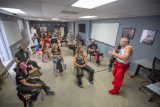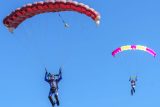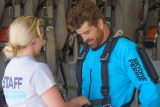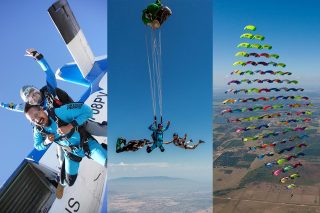Visualization: An Exercise for Success
Dan Brodsky-Chenfeld
Posted by: Skydive Perris
5 years ago

Below is an excerpt from Dan BC’s book “Above all Else” on visualization. What better to do right now than visualize successful practices if we can’t actually physically practice skydiving during this quarantine? If you’re interested in reading Dan’s highly acclaimed book “Above All Else,” it is available on Amazon by also clicking here. We highly recommend the inspirational read.
Visualization
Visualization is the ability to create clear, detailed and accurate images in your mind of something that you want to reproduce as physical reality. In essence, quality visualization is much like a very well trained imagination.
The images created by people who have practiced this skill are complete, precise and specific. We see the image and feel the movement and even the emotion so vividly that it almost seems as if we are actually doing it.
A great deal of experience and research has proven (references) that people with highly advanced visualization skills can create through visualization the same experience in their mind as that of the actual physical activity. Our minds don’t recognize much difference between full sensory visualization and actual physical training. Time spent practicing our skills through visualization can be equally as beneficial as the real thing.
Training your visualization skills:
This is very similar to training your physical skills.
- Find a quiet place where you can be without distractions. Relax, calm your mind and slow down before you begin.
- Have a clear picture that you want to start with. For instance, if you are an ice skater it would benefit you to have an actual photo of yourself at the moment when you are paused in preparation of attempting a particular move. Having this picture will help you to recreate the same image in your mind. It will then be easier to visualize a frame by frame execution of this move because you have a vivid image to start from.
- It is also very useful to previously have watched moving images of yourself, or other people performing the move you want to visualize. Watching a DVD of yourself or others executing the same skills will put a blueprint in your mind of the pictures that you want to paint.
- Take the time you need to produce the correct picture in your mind. Start with something simple. The more complex the image, the more time it will take. This can be frustrating – be patient. If the picture in your head gets scrambled stop, erase it, calm down and start again. Don’t try to force it.
- As you begin to visualize a particular action try it first in slow motion. As with training physical skills, your initial visualization training will require you to think through each part of a particular move as you create the image of that move in your mind. Once you are able to really see the correct technical move in your mind repeat the process again and again.
- With repetitions and practice your mind, like your body, will start to learn the particular skill on its own. It will develop its own mental muscle memory. Soon you will be able to think less because your mind is familiar with the picture and creates it effortlessly.
After training the ability to visualize particular images you will be able to create these images in your mind with minimal preparation. You won’t need to find a quiet place or take time to slow down and relax. You will be able to flip the switch and clearly visualize what you have practiced in any place and at any time you choose to.
Positive Visualization And Reaching Your Full Potential
Turning new skills and habits into instinct can only be done through repetition. There are no short cuts. Quality visualization allows you the opportunity to dramatically increase the amount of repetitions you can do. It gives you the chance to practice the perfect move a hundred times in only a few minutes. If your visualization skills are well trained, this practice you do in your head can be just as valuable as actual training time.
To get the most benefit, do the visualization training alongside the physical training. Work on visualizing the same skills in the evening that you are practicing during the day. As your visualization skills improve so will your actual performance. As your performance skills improves so goes your visualization. By working your visualization skills in parallel with your physical training you will reach your performance goals in a far lesser time.
Learning to visualize requires the same commitment as learning physical skills. The benefits are every bit as valuable. Some would even argue that at times the skill of creating vivid, full sensory, positive images in your mind can be just as powerful as training the physical skills themselves. I personally had two experiences which proved this to me…
I had been competing in 4-Way Formation Skydiving for 12 years and my visualization skills were excellent. I could close my eyes and see myself and the rest of the team in perfect detail. I could see my moves done correctly as well as the technically perfect choreography of the entire team. I could see the jump from above (the judging video angle), from my own eyes and even from any teammate’s point of view. I was able to run it in slow motion, or fast speed with the same precision. I didn’t need to slow down and relax. I could immediately create the images at any moment even while involved in other activities. I didn’t even need to close my eyes. I could see the correct pictures as if they were superimposed over what I was actually looking at.
All of my senses were active. I could feel the jump in my muscles and my mind would anticipate one move ahead. I was aware of my breathing and the mental calmness the sport requires. My visualization even had the confident, competitive attitude I wanted to exhibit on the skydive. For all practical purposes, I was doing the jumps. It felt the same in nearly every way.
“I could immediately create the images at any moment even while involved in other activities. I didn’t even need to close my eyes.”
The funny thing was that I took all of this completely for granted. I had no idea how good my visualization skills actually were or how crucial they were to my performance. I had practiced them frequently and thoroughly but mostly by accident. It was fun and seemed like the right thing to do. I hadn’t had a specific visualization training plan as such.
My team Arizona Airspeed won the National and World Championships in the 4-Way Formation Skydiving event two years in row. In addition to continuing with 4-Way we decided to also enter 8-Way. The rules are the same and it requires mostly the same individual flying skills. The real difference is the actual pictures that we see. 8-Way formations are twice as big as 4-Way formations. To see an entire 8-Way formation we must look much further and greatly expand our awareness. During the transitions from one formation to another there is twice as much going on and people are moving twice as far.
All in all, when you add it all up, 8-way was exponentially busier and noisier than 4-way. All of this activity made it very difficult to create the same clear images in my head that I had in 4-Way. But since I took for granted how good my visualization skills were in 4-way, I also discounted how weak they were in 8-Way.
As a 4-way competitor I was fast, precise and confident in my abilities. I deserved to be; we had just won two consecutive National and World Championships. I was sure this would carry over to 8-way. I was wrong.
When we started training 8-Way I basically stunk. I was making mistakes that could only come from a novice competitor. My flying was soft and my anticipation dull. During the video reviews of the jumps I was embarrassed. What had happened to me? I’m a World Champion. Had I lost it? Should I have quit while I was ahead? I punished myself with as much self-doubt as I could come up with.
The next day we were in the airplane on the way up for an 8-Way jump. I was visualizing the jump as I always do on the ride to altitude when it hit me. I wasn’t seeing anything. There weren’t even 8 people on the screen in my mind. There was just me, fumbling through a mass of bodies. I couldn’t even see what the formation looked like. I suddenly realized that I had no visualization skills for 8-Way. If I couldn’t see, or even imagine, what a good jump was going to look like, the odds weren’t very good that it was actually going to happen. And if it did, it would be due to nothing but pure luck. I certainly couldn’t make much of a contribution to a good effort if I didn’t know what one looked like.
“If I couldn’t see, or even imagine, what a good jump was going to look like, the odds weren’t very good that it was actually going to happen.”
Our team had two weeks off. During that time, I spent two hours (eight 15-minute sessions) a day dedicated to visualization training. I didn’t have to learn the skill of visualizing, I had extensive experience in practicing the skill with 4-way. I just had to apply that skill to a different event.
I looked at video and photographs of the formations that were taken from above and then practiced creating the same still photos in my head. I switched the “camera angle” to my point of view and practiced creating the image that I would see while in the same formation.
Once I was able to see these still photos I added movement and began working on producing the picture of what the team looked like when transitioning from one formation to another. I had to slow it way down so that I had time to paint the picture in my mind.
At first it was difficult and took quite a bit of time for each picture. But once I had accurately created the picture the first time it became much easier. With frequent, consistent training, the skill of producing the 8-way images in my mind was quickly learned.
On our first jump back after the break I was again visualizing the jump we were about to do while on the ride to altitude. I could see everything perfectly. I knew exactly how the jump was supposed to go, what I had to do to make it go that way and that I could make it go that way. I could see every detail of every person during every transition to every formation. It had a calming effect on me. The images were so clear that it felt like I had done them hundreds of times before. I knew from experience that if I could visualize the jump this clearly, all I had to do was calm myself down and let it happen. The rest would be automatic. My confidence soared.
We exited the airplane and the jump went just as planned, just as I had seen it in my head. It was amazing. I had visualized a performance level in 8-Way before actually ever performing up to that level. During our two weeks off my athletic potential didn’t change. I was the same athlete with the same skills and abilities. I already had the potential to be a good 8-Way competitor. The visualization training helped me to reach my full potential in a fraction of the time it would have taken otherwise. It happened in my head first, and my physical reality followed in line.
We exited the airplane and the jump went just as planned, just as I had seen it in my head. It was amazing. I had visualized a performance level in 8-Way before actually ever performing up to that level. During our two weeks off my athletic potential didn’t change. I was the same athlete with the same skills and abilities. I already had the potential to be a good 8-Way competitor. The visualization training helped me to reach my full potential in a fraction of the time it would have taken otherwise. It happened in my head first, and my physical reality followed in line.
“It was amazing. I had visualized a performance level in 8-Way before actually ever performing up to that level.”
Visualization Can Replace Training
I was the player/coach on the team AIRMOVES when I was seriously injured in the middle of the training year. I wasn’t able to jump and was very limited in the physical activity I could participate in. The National Championships were only a few months away. Given my condition I had to be replaced on the team by another jumper. When we arrived at the meet there were still certain types of jumps the team was weak at. We decided that because of my experience it would be a benefit to the team if on these jumps we could substitute me in for one of the other team members.
The long recovery time had greatly reduced my strength, endurance and flexibility. I was still wearing support equipment to protect injuries and was 20 pounds under my
“fighting” weight. How could it be possible that I would improve the team’s performance, or even be ready to compete at the National Championships at all, when my physical condition was marginal at best and I had barely made a jump in six months?
During my recovery I was constantly looking at videos, visualizing skydives and dreaming about jumping. As their coach, I had watched every jump the team had made at least 50 times. It felt like I was almost on the jumps with them. For these six months, I had spent more time visualizing than I had ever done before, much more. When I stepped in on the jumps I was in a different position each time. I was the skydiving equivalent of the quarterback on one jump and a wide receiver on another.
My physical condition and currency in the air were greatly compromised. The only thing in my favor was the extensive amount of visualization I had done. As it turned out, the visualization proved to be worth more than the actual training could have been. In the airplane I was able to visualize the jumps perfectly. I felt confident and ready to do any job required of me. It seemed like I had done all of these moves only yesterday because basically I had. All the positions and moves felt familiar.
Even though all the physical evidence would dictate otherwise, when visualizing in the plane I felt like I had every reason to expect we’d have great jump and my confidence was high.
The extensive visualization training I had done basically replaced the lack of any significant physical training. I don’t recommend this as a training plan, but it does demonstrate how powerful quality visualization can be. Don’t underestimate it. Be sure and give visualization training a valuable place in your training program.
If you’re interested in reading Dan’s highly acclaimed book “Above All Else” it is available on Amazon by also clicking here. We highly recommend it as it’s a very inspirational read.
Categories:
You May Be Interested In:

2020: The Year We’ll Never Forget (No matter how hard we try)
5 years ago by Skydive Perris

Ask Dan BC ANYTHING! A webinar with Skydive Perris’ Manager
5 years ago by Skydive Perris

Safety, Safety, Safety by Dan BC!
5 years ago by Skydive Perris

Mastering The Art of Gear Checks With Dan BC
5 years ago by Skydive Perris

